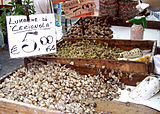Abalone
| Abalone | |
|---|---|
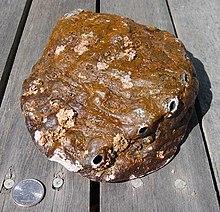
| |
| The shell of a red abalone | |
| Scientific classification | |
| Kingdom: | |
| Phylum: | |
| Class: | |
| Superfamily: | |
| (unranked): | clade Vetigastropoda
|
| Family: | Haliotidae Rafinesque, 1815
|
| Genus: | Haliotis Linnaeus, 1758
|
| Species | |
|
Many, see species section. | |
Abalone (from Spanish Abulón) are medium-sized to very large edible sea snails, marine gastropod mollusks in the family Haliotidae and the genus Haliotis. Common names for abalones also include ear-shells, sea-ears and Venus's-ears, as well as muttonfish or muttonshells in Australia, ormer in Jersey and Guernsey, perlemoen in South Africa and pāua in New Zealand.
There is only the one genus in the family Haliotidae, and about four to seven subgenera. The number of species recognized worldwide is about 100.
The shells of abalones have a low and open spiral structure, and are characterized by several open respiratory pores in a row near the shell's outer edge. The thick inner layer of the shell is composed of nacre or mother-of-pearl, which in many species is highly iridescent, giving rise to a range of strong and changeable colors, which make the shells attractive to humans as decorative objects, and as a source of colorful mother-of-pearl.
The flesh (the adductor muscle) of abalones is widely considered to be a desirable food.
Description


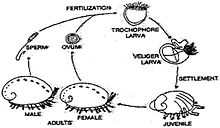
The shell of abalones has a convex, rounded to oval shape, and the shell may be highly arched or very flattened. The shell is slightly spiral, with two to three whorls, the last one aeriform such that the shell resembles an "ear", giving rise to the common name ‘ear-shell’. The body whorl has a series of holes—four to ten depending on the species—near the anterior margin, for the escape of water from the gills. There is no operculum.
The color of the shell is very variable from species to species. The iridescent nacre that lines the inside of the shell varies in color from silvery white, to pink, red and green-red, through to Haliotis iris, which shows predominantly deep blues, greens and purples.
These snails cling solidly with their broad muscular foot to rocky surfaces at sublittoral depths, although some species such as Haliotis cracherodii used to be common in the intertidal zone. Abalones reach maturity at a relatively small size. Their fecundity is high and increases with their size (from 10,000 to 11 million eggs at a time).
The larvae are lecithotrophic or feed off a yolk sac. The adults are herbivorous and feed with their rhipidoglossan radula on macroalgae, preferring red or brown algae. Sizes vary from 20 mm (Haliotis pulcherrima) to 200 mm (or even more) (Haliotis rufescens). They also have a series of small holes on top of the shell through which sex products and waste are expelled.
Distribution
The haliotid family has a worldwide distribution, along the coastal waters of every continent, except the Atlantic coast of South America, the Caribbean, and the East Coast of the United States.
The majority of abalone species are found in cold waters, off the Southern Hemisphere coasts of New Zealand, South Africa and Australia, and Western North America and Japan in the Northern Hemisphere.
The species of sea snail which is known in the sea food trade as the "Chilean abalone", Concholepas concholepas, is from another family altogether. It is not a true abalone at all, but a muricid, or rock snail.
Structure and properties of abalone shell
The shell of the abalone is exceptionally strong. It is made of microscopic calcium carbonate tiles stacked like bricks. Between the layers of shells is a clingy protein substance. When the abalone shell is struck, the tiles slide instead of shattering and the protein stretches to absorb the energy of the blow. Material scientists around the world are studying the tiled structure for insight into stronger ceramic products such as body armor.[1]
The dust created through the grinding and cutting of abalone shell is dangerous; appropriate safeguards must be taken to protect people from inhaling these particles. An N95-rated dust respirator, a ventilation system, and wet grinding are requirements to working abalone shell safely. The calcium carbonate dust is a respiratory irritant and the particles can penetrate into the lower respiratory tree and cause irritant bronchitis and other respiratory irritation responses. The usual symptoms are cough and sputum production, and secondary infections can occur. If there are proteins left in the shell matrix, it is also possible that they can trigger an allergic (asthmatic) attack. Allergic skin reactions can also occur.
Diseases
Abalones are subject to various diseases. The New South Wales Department of Primary Industries said in 2007 that abalone viral ganglioneuritis, or AVG, killed up to 90% of stock in affected regions. Abalone are also severe hemophiliacs as their fluids will not clot in the case of a laceration or puncture wound. Using abalone as bait or burley is illegal in NSW.[2]
Sport harvesting
Tasmania - Australia
Tasmania provides approximately 25% of the yearly world abalone harvest[3]. Around 12,500 Tasmanians recreationally fish for blacklip and greenlip abalone. For blacklip abalone, the size limit varies from between 138 mm for the southern end of the state and 127 mm for the northern end of the state[4]. Greenlip abalone have a minimum size of 145 mm, except for an area around Perkin's Bay in the north of the state where the minimum size is 132 mm. With a recreational abalone licence, there is a bag limit of 10 per day, and a total possession limit of 20. Scuba diving for abalone is allowed and has a rich history in Australia. (Scuba diving for abalone in the state of New South Wales is illegal, where a free diving catch limit of two is permitted).[5][6]
California

Sport harvesting of red abalone is permitted with a California fishing license and an abalone stamp card. New in 2008, the abalone card also comes with a set of 24 tags. Legal-size abalone must be tagged immediately. Abalone may only be taken using breath-hold techniques or shorepicking; scuba diving for abalone is strictly prohibited. Taking of abalone is not permitted south of the mouth of the San Francisco Bay. There is a size minimum of seven inches (178 mm) measured across the shell and a quantity limit of three per day and 24 per year. A person may be in possession of only three abalone at any given time.
Abalone may only be taken from April to November, not including July. Transportation of abalone may only legally occur while the abalone is still attached in the shell. Sale of sport-obtained abalone is illegal, including the shell. Only red abalone may be taken; black, white, pink, and flat abalone are protected by law.
An abalone diver is normally equipped with a thick wetsuit, including a hood, booties, and gloves, and usually also a mask, snorkel, weight belt, abalone iron, and abalone gauge. Alternatively, the rock picker can feel underneath rocks at low tides for abalone. Abalone are mostly taken in depths from a few inches up to 10 m (33 ft); less common are freedivers who can work deeper than 10 m (33 ft). Abalone are normally found on rocks near food sources (kelp). An abalone iron is used to pry the abalone from the rock before it can fully clamp down. Divers commonly dive out of boats, kayaks, tube floats or directly off the shore. An eight-inch (203 mm) abalone is considered a good catch, a nine-inch (229 mm) abalone extremely good, and a ten-inch (254 mm) or larger abalone a trophy catch.
There has been a trade in diving to catch abalones off parts of the United States coast from before 1939. In World War II, many of these abalone divers were recruited into the United States armed forces and trained as frogmen.
The largest abalone recorded in California is 12.34 inches (313 mm), caught by John Pepper somewhere off the coast of Humboldt county.[citation needed]
New Zealand
There is an extensive global black market in the collection and export of abalone meat. In New Zealand, where abalone is called pāua (from the Māori language), this can be a particularly awkward problem where the right to harvest pāua can be granted legally under Māori customary rights. When such permits to harvest are abused, it is frequently difficult to police. The legal recreational daily limit is 10 pāua per diver with a minimum shell length of 125 mm. The limit is strictly enforced by roving Ministry of Fisheries officers with the backing of the police. Pāua 'poaching' is a major industry in New Zealand with many thousands being taken illegally, often undersized. Convictions have resulted in seizure of diving gear, boats, and motor vehicles as well as fines and in rare cases, imprisonment. The Ministry of Fisheries expects in the year 2004/05, nearly 1,000 tons of pāua will be poached, with 75% of that being undersized.[7]
Highly polished New Zealand pāua shells are extremely popular as souvenirs with their striking blue, green, and purple iridescence.
South Africa
The largest abalone in South Africa, the Perlemoen, Haliotis midae, occurs along approximately two-thirds of the country’s coastline. Perlemoen-diving has been a recreational activity for many years, but stocks are currently being threatened by illegal commercial harvesting. In South Africa all persons harvesting this animal need permits that are issued on a yearly basis, and no abalone may be harvested using scuba gear.
For the last few years, however, no permits have been issued for collecting Abalone (Perlemoen), but commercial harvesting still continues as does illegal collection by syndicates.[8] In 2007, because of widespread poaching of abalone, the South African government listed perlemoen as an endangered species according to the CITES section III appendix, which requests member governments to monitor the trade in this species. The abalone meat from South Africa is prohibited for sale in the country to help reduce poaching however, much of the illegally harvested meat is sold in Asian countries. As of early 2008, the wholesale price for abalone meat was approximately US$40.00 per kilogram. There is an active trade in the shells which sell for more than US$1,400 per metric tonne. There is, however, speculation that local criminal gangs barter Abalone illegally with Chinese nationals in exchange for chemicals used in the production of drugs, reducing the need for the use of money and hence avoiding money laundering issues. [9]
Channel Islands
Ormers (Haliotis tuberculata) are considered a delicacy in the British Channel Islands and are pursued with great alacrity by the locals. This has led to a dramatic depletion in numbers since the latter half of the 19th century, and 'ormering' is now strictly regulated in order to preserve stocks. The gathering of ormers is now restricted to a number of 'ormering tides', from January 1 to April 30, which occur on the full or new moon and two days following. No ormers may be taken from the beach that are under 80 mm in shell length. Gatherers are not allowed to wear wetsuits or even put their heads underwater. Any breach of these laws is a criminal offence and can lead to fine of up to £5,000 or six months in prison [1]. The demand for ormers is such that they led to the world's first underwater arrest, when Mr. Kempthorne-Leigh of Guernsey was arrested by a police officer in full diving gear when illegally diving for ormers.
Farming
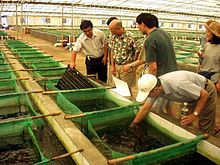
Farming of abalone began in the late 1950s and early 1960s in Japan and China.[10] Since the mid-1990s, there have been many increasingly successful endeavors to commercially farm abalone for the purpose of consumption.[11] Over-fishing and poaching have reduced wild populations to such an extent that farmed abalone now supplies most of the abalone meat consumed. The principal abalone farming regions are China's mainland, Taiwan, Japan, and Korea. Abalone is also farmed in Australia, Canada, Chile, Iceland, Ireland, Mexico, Namibia, New Zealand, South Africa, Thailand, and the United States.[12]
Human use
Meat of abalones is used for consumption and shells of abalones are used as decorative items.
Consumption


Abalone has long been a valuable food source for humans in every area of the world where a species is, or used to be, abundant. The various larger species of abalones have been exploited commercially for food to the extent that many populations are now severely threatened.
The meat of this mollusk is considered a delicacy in certain parts of Latin America (especially Chile), France, New Zealand, South East Asia, and East Asia (especially in China, Japan, and Korea). In Chinese speaking regions, abalone are commonly known as bao yu, and sometimes forms part of a Chinese banquet. Similar to shark fin soup or birds nest soup, it is considered a symbol of wealth and prestige, and is traditionally reserved for special occasions such as weddings and other celebrations. However, the availability of commercially farmed abalone has allowed more common consumption of this once rare delicacy.
In Japan, live and raw abalone is used in awabi sushi, or served steamed, salted, boiled, chopped, or simmered in soy sauce. Salted, fermented abalone entrails are the main component of tottsuru, a local dish from Honshū. Tottsuru is mainly enjoyed with sake.[13]
In California abalone receives more relaxed treatment and can be found on pizza, sautéed with caramelized mango or in steak form dusted with cracker meal and flour.[14]
The mollusc Concholepas concholepas is often sold in the United States under the name Chilean abalone, even though it is not an abalone but a muricid.
Decorative items
The highly iridescent inner nacre layer of the shell of abalone has traditionally been used as a decorative item in jewelry, buttons, and as inlay in furniture and in musical instruments such as guitars, etc. The Abalone pearl, with its scarcity and impending extinction prove itself the ultimate prize for the knowledgeable and informed jewelry collector.
Abalone pearl jewelry is very popular in New Zealand and Australia, in no minor part due to the marketing and farming efforts of pearl companies. Unlike the Oriental Natural, the Akoya pearl, and the South Sea and Tahitian cultured pearls, abalone pearls are not primarily judged by their roundness. Also, unlike other types of pearls, abalone pearls are not subjected to any type of processing, such as bleaching or buffing.
Species
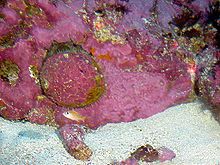
- Haliotis australis, Australian abalone, Austral abalone
- Haliotis ancile, Shield abalone
- Haliotis aquatilis, Japanese abalone
- Haliotis asinina, Ass’s ear abalone
- Haliotis barbouri
- Haliotis brazieri, Brazier’s abalone
- Haliotis clathrata
- Haliotis chimcham Chimcham abalone
- Haliotis coccoradiata, Reddish-rayed abalone
- Haliotis conicopora, Conical pore abalone, brownlip abalone
- Haliotis corrugata, Pink abalone
- Haliotis cracherodii, Black abalone
- Haliotis crebrisculpta, Close sculptures abalone
- Haliotis cyclobates, Whirling abalone
- Haliotis dalli, Dall’s abalone
- Haliotis discus, Disk abalone
- Haliotis dissona
- Haliotis diversicolor supertexta, Taiwan abalone, jiukong
- Haliotis diversicolor, Variously coloured abalone
- Haliotis dohrniana, Dhorn’s abalone
- Haliotis elegans, Elegant abalone
- Haliotis emmae, Emma’s abalone
- Haliotis ethologus, Mimic abalone
- Haliotis exigua
- Haliotis fatui
- Haliotis fulgens, Green abalone
- Haliotis gigantea, Giant abalone, Awabi
- Haliotis glabra, Glistening abalone
- Haliotis hargravesi, Hargraves’s abalone
- Haliotis howensis, Lord Howe abalone
- Haliotis iris, Blackfoot abalone, Rainbow abalone, Pāua
- Haliotis jacnensis, Jacna abalone
- Haliotis kamtschatkana, Pinto abalone
- Haliotis kamtschatkana assimilis
- Haliotis kamtschatkana kamtschatkana
- Haliotis laevigata, Smooth Australian abalone, greenlip abalone
- Haliotis madaka
- Haliotis mariae
- Haliotis melculus, Honey Abalone
- Haliotis marfaloni, Marfalo Abalone
- Haliotis midae, Midas ear abalone, perlemoen abalone, South African abalone
- Haliotis multiperforata, Many-holed abalone
- Haliotis ovina, Oval abalone, sheep's ear abalone
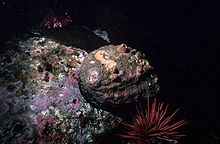
Pink abalone, Haliotis corrugata - Haliotis parva, Canaliculate abalone
- Haliotis patamakanthini
- Haliotis planata, Planate abalone
- Haliotis pourtalesii, Pourtale’s abalone
- Haliotis pulcherrima, Most beautiful abalone
- Haliotis pustulata
- Haliotis queketti, Quekett’s abalone
- Haliotis roberti
- Haliotis roei, Roe's abalone
- Haliotis rosacea, Rosy abalone
- Haliotis rubiginosa
- Haliotis rubra, Ruber abalone
- Haliotis rufescens, Red abalone
- Haliotis rugosa
- Haliotis scalaris, Staircase abalone, ridged ear abalone
- Haliotis schmackenmuut, Norweigan Schmackenmuut Bay abalone
- Haliotis semiplicata, Semiplicate abalone
- Haliotis sorenseni, White abalone
- Haliotis spadicea, Blood-spotted abalone
- Haliotis speciosa, Splendid abalone
- Haliotis squamata, Scaly Australian abalone
- Haliotis squamosa, Squamose abalone
- Haliotis thailandis
- Haliotis tuberculata, Green ormer, European edible abalone, tube abalone, tuberculate ormer
- Haliotis unilateralis
- Haliotis varia, Variable abalone
- Haliotis venusta, Lovely abalone
- Haliotis virginea, Virgin abalone
- Haliotis walallensis, Northern green abalone, flat abalone
- Haliotis assimilis, Threaded abalone
References
- ^ Lin, A. (2005). "Growth and structure in abalone shell". Materials Science and Engineering a. 390 (Jan. 15): 27–41. doi:10.1016/j.msea.2004.06.072+.
{{cite journal}}: Unknown parameter|coauthors=ignored (|author=suggested) (help) - ^ http://www.dpi.nsw.gov.au/aboutus/news/recent-news/fishing-and-aquaculture/abalone-gut-bait-ban
- ^ "Abalone Viral Ganglioneuritis". Retrieved 2008-01-16.
- ^ "Abalone Fishing". Retrieved 2008-01-16.
- ^ Wong, RM (2001). "Abalone diving in Western Australia diving practices in 1999". South Pacific Underwater Medicine Society Journal. 31 (3). Retrieved 2008-10-14.
- ^ Pollard, G (2001). "Abalone fishing in south Australia". South Pacific Underwater Medicine Society Journal. 31 (3). Retrieved 2008-10-14.
- ^ http://www.fish.govt.nz/information/corp-docs/soi-04-08/pau2-industry-association.pdf
- ^ "Six arrested in massive perlemoen bust". Mail & Guardian. 11 April 2008. Retrieved 11 November 2008.
- ^ http://www.capeargus.co.za/?fSectionId=3571&fArticleId=vn20090411065235212C189274
- ^ "Abalone Farming Information". Retrieved 2007-11-08.
- ^ "Abalone Farming on a Boat". Retrieved 2007-01-27.
- ^ "Abalone Farming Around the World". Retrieved 2007-11-08.
- ^ Akimichi, Tomoya. "The Enduring Appeal of Abalone". article. The Japanese Table. Retrieved 2008-10-14.
- ^ Gayot, Alain (2008-09-22). "Maritime Morsels". article. The Food Paper. Retrieved 2008-10-14.
External links
- Abalone: Species Diversity
- Abalone biology
- Conchology
- Hardy's Internet Guide to Marine Gastropods : Shell Catalog
- book on crafting with Abalone Shell
- Imagemap of worldwide abalone distribution
- [2]Pro abalone diver, Mallacoota, Victoria (1967)
- [3]Tathra NSW(1961), Abalone (1963)


